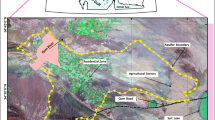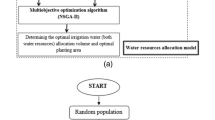Abstract
Droughts and climate variability cause uncertainties on water supply especially in arid regions and coastal aquifers’ over-exploitation causes seawater intrusion. Since the rate and extent of aquifer recharge is often very uncertain, determining the optimal groundwater abstraction is a challenging task. In this paper a framework is proposed for estimating the optimal abstraction of groundwater for urban supply under uncertainty and under complex conditions of water table fluctuations and seawater intrusion. It is based on a combination of several models: (i) a Monte-Carlo Simulation (MCS) to incorporate the uncertainties in groundwater recharge, (ii) a numerical groundwater flow model, MODFLOW to simulate the effects of abstractions on the water table fluctuations and seawater intrusion and (iii) a multi-objective optimization model to generate the set of Pareto optimal solutions for each recharging scenario. Maximizing the benefit to the water utility, minimizing the average groundwater table level fluctuations and minimizing the seawater intrusion are the objectives of the model. A fast multi-objective evolutionary algorithm is used to obtain the Pareto efficient solutions for each recharging scenario. Compromise programming (CP) is then used to select the closest solutions to the ideal. Finally, the amount of optimal reliable groundwater abstraction is estimated using a cumulative distribution function. The proposed methodology is applied to a coastal aquifer in the western part of Muscat metropolitan area, Oman. The results have shown that annual groundwater abstraction volume may range from 12.7 to 18.8 Mm3 compared to 6.8 Mm3 currently pumped. This would result in an economic benefit of $10.5 million to $15.4 million/year. On the other hand the aquifer’s maximum annual mean drawdown would range from 0.7 to 0.9 m.




Similar content being viewed by others
References
Abdalla O, Al-Abri R (2011) Groundwater recharge in arid areas induced by tropical cyclones: lessons learned from Gonu 2007 in Sultanate of Oman. Environ Earth Sci 63:229–239. doi:10.1007/s12665-010-0688-y
Abdalla O, Al-Rawahi AS (2013) Groundwater recharge dams in arid areas as tools for aquifer replenishment and mitigating seawater intrusion: example of Al-Khod, Oman. Environ Earth Sci 69:1951–1962
Abrishamchi A, Ebrahimian A, Tajrishi M, Mariño M (2005) Case study: application of multicriteria decision making to urban water supply. J Water Resour Plan Manag 131(4):326–335
Al-Ismaily S, Al-Maktoumi A, Kacimov A, Al-Saqri S, Al-Busaidi H (2013) The impact of a recharge dam on the hydropedology of arid zone soils in oman: anthropogenic formation factor. J Hydrol Eng. 10.1061/(ASCE)HE.1943-5584.0000886, 04014053
Al-Khamisi S (2012) Optimal water resources managemnet model for Ash Sharqiyah region domestic water supply, Oman. PhD Thesis, Heriot-Watt University, Edinburgh, UK
Al-Maktoumi A (2007) Deterioration of layered coastal aquifer water due to density dependent flows. PhD Dissertation. The University of Queensland, Brisbane, Australia
Baawain M (2010) Wastewater treatment in oman: current practice and way forward. In: Symposiumof World Environment Day. 5th June 2010. Sultan Qaboos University, Muscat, Oman
Bashi-Azghadi SN, Kerachian R, Bazargan-Lari MR, Solouki K (2010) Characterizing an unknown pollution source in groundwater resources systems using PSVM and PNN. Expert Syst Appl 37(10):7154–7161
Bazargan-Lari M, Kerachian R, Mansoori A (2009) A conflict-resolution model for the conjunctive use of surface and groundwater resources that considers water-quality issues: a case study. Environ Manag 43(3):470–482
Bazargan-Lari M, Kerachian R, Afshar H, Bashi-Azghadi SN (2013) Developing an optimal valve closing rule curve for real-time pressure control in pipes. J Mech Sci Technol 27(1):215–225
Blair DA, Spronz WD, Ryan KW (1999) Brackish groundwater desalination: a community’s solution to water supply and aquifer protection. J Am Water Resour Assoc 34(5):1201–1212
Cai J, Taute T, Schneider M (2015) Recommendations of controlling saltwater intrusion in an inland aquifer for drinking-water supply at a certain waterworks site in Berlin (Germany). Water resources management. In Press
Chitrakar P (2014) Transient groundwater flow modeling of Al-Batinah coastal Region (Barka). MSc Thesis. Sultan Qaboos University, Oman
Coulibaly P, Anctil F, Aravena R, Bobée B (2001) Artificial neural network modeling of water table depth fluctuations. Water Resour Res 37(4):885–896
Daneshmand F, Karimi A, Nikoo M, Bazargan-Lari M, Adamowski J (2014) Mitigating socio-economic-environmental impacts during drought periods by optimizing the conjunctive management of water resources. Water Resour Manag 28(6):1517–1529
Deb K, Agrawal S, Pratap A, Meyarivan T (2000) A fast elitist non-dominated sorting genetic algorithm for multi-objective optimization: NSGA-II. In: Schoenauer M, Deb K, Rudolph G, Yao X, Lutton E, Merelo J, Schwefel H-P (eds) Parallel problem solving from nature PPSN VI Vol. 1917. Springer, Berlin, pp 849–858
Deb K, Pratap A, Agarwal S, Meyarivan T (2002) A fast and elitist multiobjective genetic algorithm: NSGA-II. Evol Comput IEEE Trans 6(2):182–197
Dhar A, Datta B (2009) Saltwater intrusion management of coastal aquifers. i: linked simulation-optimization. J Hydrol Eng 14(12):1263–1272. doi:10.1061/(ASCE)HE.1943-5584.0000097
Doherty J (2004) PEST – model independent parameter estimation (5th edn. of User Manual) watermark numerical computing, Brisbane, Australia
Druetta P, Aguirre P, Mussati S (2014) Minimizing the total cost of multi effect evaporation systems for seawater desalination. Desalination 344:431–445
Ebrahim GY (2013) Modeling groundwater systems: understanding and improving groundwater quantity and quality management. PhD Thesis, Delft University of technology, the Netherlands. ISBN: 978-1-138-02404-5
Ebrahim GY, Jonoski A, Al-Maktoomi A, Ahmed M, Mynett A (2015) A simulation-optimization approach for hydraulic evaluation of managed aquifer recharge in the samail lower catchment, Oman. Water resources management, accepted for publication
Feo J, Jaime Sadhwani J, Alvarez L (2012) More efficient production line with desalination plants using reverse osmosis. Desalin Water Treat 51(1–3):307–317
Fernández-Santos X, Zekri S, Herruzo AC (1993) On farm costs of reducing nitrogen pollution through BMP’S. Agric Ecosyst Environ 45:1–11
Freeze RA, Cherry JA (1979) Groundwater. Prentice-Hall, Inc. Englewood Cliffs, NJ, p 604
Fuentes-Bargues JL (2014) Analysis of the process of environmental impact assessment for seawater desalination plants in Spain. Desalination 347:166–174
Harbaugh AW, McDonald MG (1996) User’s documentation for MODFLOW-96: an update to the US geological survey modular finite-difference groundwater flow model. US geological survey open-file report 96–485
Harbaugh AW, Banta ER, Hill MC, McDonald MG (2000) MODFLOW-2000, the US geological survey modular ground-water model: user guide to modularization concepts and the ground-water flow process 121, Reston, VA, USA
Holzbecher EO (1998) Modeling density-dependent flow in porous media: principles, numerics, software. Springer, Germeny, ISBN 3-540-63677-3
Höpner T, Windelberg J (1997) Elements of environmental impact studies on coastal desalination plants. Desalination 108(1–3):11–18
Javadi A, Hussain M, Sherif M, Farmani R (2015) Multi-objective optimization of different management scenarios to control seawater intrusion in coastal aquifers. Water Resour Manag 29(6):1843–1857
Kacimov AR, Sherif MM (2006) Modelling of groundwater in two selected coastal aquifers of UAE and Oman as a precursor for water resources management. Final report: United Arab Emirates University and Sultan Qaboos University
Kacimov AR, Al-Ismaili S, Al-Maktoumi A (2010) The green-Ampt 1-D infiltration from a ponded surface into a heterogeneous soil. J Irrig Drain Eng 136(1):68–72, ISSN0733-9437/2010/1-68-72
Kwarteng AY, Dorvlo AS, Vijaya Kumar GT (2009) Analysis of a 27-year rainfall data (1977–2003) in the Sultanate of Oman. Int J Climatol 29(4):605–617
Lattemann S, Höpner T (2008) Environmental impact and impact assessment of seawater desalination. Desalination 220(1–3):1–15
McDonald MG, Harbaugh AW (2003) The history of MODFLOW. Ground Water 41(2):280–283
MWR (1993) Ministry of water resources of the sultanate of Oman: sea water intrusion beneath the Batinah Coast. Comparison of results of salinity surveys
Oswald SE, Kinzelbach W (2004) Three-dimensional physical benchmark experiments to test variable-dernsity flow models. J Hydrol 290(1–2):22–42
PAEW (2014) Public authority for electricity and water: quality water for Oman, annual report 2013, Muscat
Prante JL, Ruskowitz JA, Childress AE, Achilli A (2014) RO-PRO desalination: an integrated low-energy approach to seawater desalination. Appl Energy 120:104–114
Rafipour-Langeroudi M, Kerachian R, Bazargan-Lari M (2014) Developing operating rules for conjunctive use of surface and groundwater considering the water quality issues. KSCE J Civ Eng 18(2):454–461
Ralston DK, Keafer BA, Brosnahan ML, Anderson DM (2014) Temperature dependence of an estuarine harmful algal bloom: resolving interannual variability in bloom dynamics using a degree-day approach. J Limnol Oceanogr 59(4):1112–1126
Saif Y, Almansoori A (2014) Design and operation of water desalination supply chain using mathematical modelling approach. Desalination 351:184–201
Sen Z (2008) Wadi hydrology. CRC Press, NW. ISBN 978-1-4200-6154-3
Shah N, Nachabe M, Ross M (2007) Extinction depth and evapotranspiration from ground water under selected land covers. Ground Water 45(3):329–338
Sherif M (2014) Freshwater storage and recovery in groundwater systems. In: Symposium on “disposal of large volumes of water: challenges and opportunities for aid environments in MAR practices”. 15–16 June 2014 Muscat, Oman
Shiau JT, Wu FC (2006) Compromise programming methodology for determining instream flow under multiobjective water allocation criteria. JAWRA 42(5):1179–1191
Singh A (2014) Optimization modelling for seawater intrusion management. J Hydrol 508:43–52
Sreekanth J, Datta B (2011) Optimal combined operation of production and barrier wells for the control of saltwater intrusion in coastal groundwater well fields. Desalin Water Treat 32(1–3):72–78
Sreekanth J, Datta B (2014) Stochastic and robust multi-objective optimal management of pumping from coastal aquifers under parameter uncertainty. Water Resour Manag 28(7):2005–2019
Wilf M, Bartels C (2005) Optimization of seawater RO systems design. Desalination 173(1):1–12
Zekri S (2008) Using economic incentives and regulations to reduce seawater intrusion in the Batinah coastal area of Oman. Agric Water Manag 95(3):243–252
Zekri S (2009) Controlling groundwater pumping online. J Environ Manag 90:3581–3588
Zekri S, Romero C (1993) Public and private compromises in agricultural water management. J Environ Manag 37:281–300
Zekri S, Al-Maktoumi A, Abdalla O, Akil J, Charabi Y (2014) Hydrogeological and economical simulation: water provision in emergency situation for Muscat. Water Policy 16:340–357. doi:10.2166/wp.2013.187
Acknowledgments
This research has been partially supported through the internal grant IG/ENG/MIED/14/01 from Sultan Qaboos University. This financial support is gratefully acknowledged.
Author information
Authors and Affiliations
Corresponding author
Rights and permissions
About this article
Cite this article
Zekri, S., Triki, C., Al-Maktoumi, A. et al. An Optimization-Simulation Approach for Groundwater Abstraction under Recharge Uncertainty. Water Resour Manage 29, 3681–3695 (2015). https://doi.org/10.1007/s11269-015-1023-x
Received:
Accepted:
Published:
Issue Date:
DOI: https://doi.org/10.1007/s11269-015-1023-x




